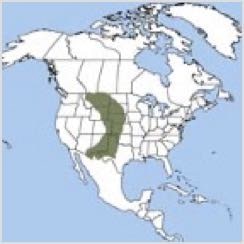Black-Tailed Prairie Dog
Cynomys ludovicianus
Conservation Status: Listed as threatened in the Endangered Species Act.
Characteristics:
- They are rodents native to the grasslands of North America.
- There are five different species of prairie dogs:
o Black-tailed
o White-tailed
o Gunnison’s
o Utah
o Mexican - Black-Tailed prairie dogs are generally tan in color with lighter-colored bellies.
- Their tails have black tips, from which their name is derived.
- Adults can weight from 1.5 to 3 lbs.; males are typically heavier than females.
- Body length is normally from 14 to 17 inches, with a 3 to 4 inch tail.
Lifespan: In the wild, 3 to 5 years. In captivity, up to 8 years.
Range and Habitat:
- Northern American short grass prairie, mixed-grass prairie, sagebrush steppe and desert grassland.
- Presently 11 states in the United States including Arizona, Colorado, Kansas, Montana, Nebraska, New Mexico, North Dakota, Oklahoma, South Dakota, Texas, and Wyoming.

Diet:
- Grasses, sedges, flowering plants, roots and seeds.
- They also are knowing to eat insects.
- In captivity their diet consists of whole shelled corn and alpha pellets.
Behavior:
- Prairie dogs are very social and live in closely-knit family groups called “coteries”.
- Coteries usually contain an adult male, one or more adult females and their offspring.
- These coteries are grouped together into wards (or neighborhoods) and several wards make up a colony or town.
- They live in underground burrows, made up of a system of tunnels and chambers marked by many mounds of packed earth at the entrances.
- These burrows have nurseries, sleeping quarters, and even restrooms.
- They create listening posts near exits, so they can safely observe the movements of predators.
- They spend a lot of time building and rebuilding their dwellings.
Fun Facts:
- Their entire mating season is just an hour long. Females go into estrus for a single hour.
- Their vocabulary is more advanced than any other animal language that has been decoded.
- They are cousins of backyard squirrels.
- Black-footed ferrets depend on prairie dogs. Prairie dogs are the primary source of food for the endangered black-footed ferrets. The health of prairie dog colonies are being analyzed and identified for ferret release.
Keeper Notes:
Our town has approximately 15 prairie dogs. In the winter, 4 to 5 prairie dogs may emerge to sun themselves or to get a bite to eat. Mating season begins in March and 4 to 8 babies emerge in early May. In the summer, at least 12-15 prairie dogs can be seen throughout the day. Their favorite enrichment items include peanut butter sticks covered with corn, dried meal worms, and pea pods.

